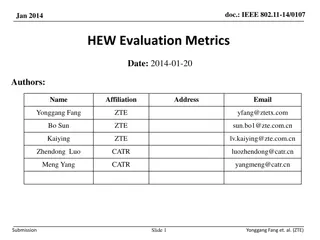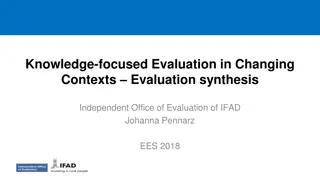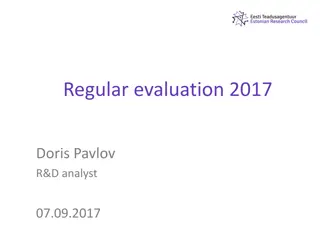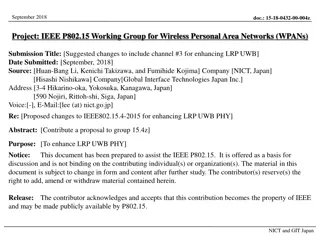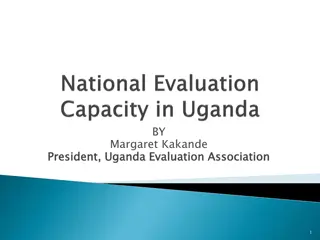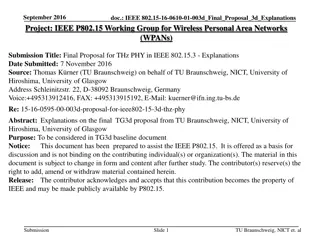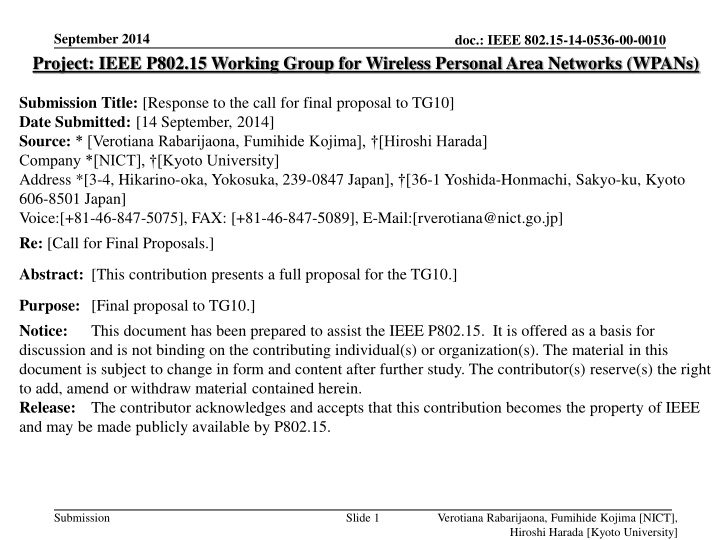
Hierarchical Mesh Tree Routing Proposal for IEEE P802.15-14-0536-00-0010
This document presents a comprehensive proposal for Hierarchical Mesh Tree (HMT) routing in the IEEE P802.15 Working Group for Wireless Personal Area Networks (WPANs). The submission encompasses the construction, maintenance, and update of the HMT, with a focus on routing strategies based on link quality metrics. The proposal aims to enhance data aggregation and network efficiency within WPANs.
Download Presentation

Please find below an Image/Link to download the presentation.
The content on the website is provided AS IS for your information and personal use only. It may not be sold, licensed, or shared on other websites without obtaining consent from the author. If you encounter any issues during the download, it is possible that the publisher has removed the file from their server.
You are allowed to download the files provided on this website for personal or commercial use, subject to the condition that they are used lawfully. All files are the property of their respective owners.
The content on the website is provided AS IS for your information and personal use only. It may not be sold, licensed, or shared on other websites without obtaining consent from the author.
E N D
Presentation Transcript
September 2014 Project: IEEE P802.15 Working Group for Wireless Personal Area Networks (WPANs) doc.: IEEE 802.15-14-0536-00-0010 Submission Title: [Response to the call for final proposal to TG10] Date Submitted: [14 September, 2014] Source:* [Verotiana Rabarijaona, Fumihide Kojima], [Hiroshi Harada] Company *[NICT], [Kyoto University] Address *[3-4, Hikarino-oka, Yokosuka, 239-0847 Japan], [36-1 Yoshida-Honmachi, Sakyo-ku, Kyoto 606-8501 Japan] Voice:[+81-46-847-5075], FAX: [+81-46-847-5089], E-Mail:[rverotiana@nict.go.jp] Re: [Call for Final Proposals.] Abstract: [This contribution presents a full proposal for the TG10.] Purpose: [Final proposal to TG10.] Notice: This document has been prepared to assist the IEEE P802.15. It is offered as a basis for discussion and is not binding on the contributing individual(s) or organization(s). The material in this document is subject to change in form and content after further study. The contributor(s) reserve(s) the right to add, amend or withdraw material contained herein. Release: The contributor acknowledges and accepts that this contribution becomes the property of IEEE and may be made publicly available by P802.15. Submission Slide 1 Verotiana Rabarijaona, Fumihide Kojima [NICT], Hiroshi Harada [Kyoto University]
September 2014 doc.: IEEE 802.15-14-0536-00-0010 Hierarchical Mesh Tree Routing Verotiana Rabarijaona, Fumihide Kojima (NICT), Hiroshi Harada (Kyoto University) Submission Slide 2 Verotiana Rabarijaona, Fumihide Kojima [NICT], Hiroshi Harada [Kyoto University]
September 2014 doc.: IEEE 802.15-14-0536-00-0010 Outline Review of the proposal Proposed IEs Requirements and simulation scenario Simulation results Data aggregation evaluation Submission Slide 3 Verotiana Rabarijaona, Fumihide Kojima [NICT], Hiroshi Harada [Kyoto University]
September 2014 doc.: IEEE 802.15-14-0536-00-0010 HMT construction, maintenance and update The neighbor table is built and maintained through periodic EB broadcasts A node s depth and the neighbor table is updated according to the changes in the network reflected by the presence/absence of EBs Parent-child link Brotherhood link Parent-child link Brotherhood link Depth Depth R R 0 0 B B F F D D 1 1 C C E E A A J L K J 2 2 L M K I H I G G O M N H 3 3 N Submission Slide 4 Verotiana Rabarijaona, Fumihide Kojima [NICT], Hiroshi Harada [Kyoto University]
September 2014 doc.: IEEE 802.15-14-0536-00-0010 HMT Routing - Upstream(1) Based on a link quality metric (BER, success rate, latency, SINR ). The metric(s) to be used is determined by the root of the tree and spread through EBs Routing through parents and/or brothers with priority given to the parents through a Link Quality Threshold (LQT) w.r.t the chosen metric: If the metric offered by the best parent does not satisfy the LQT, the packet is routed through the best brother. If the metric offered by the best brother does not satisfy the LQT, the packet is routed through the device with the best metric between the best parent and the best brother. The LQT may be set globally by the root, or locally and dynamically by a device to adapt to the local channel conditions A node holds the list of TAs and RAs of a packet with a given (SN, SA, DA) tuple. In order to avoid loops, a node shall select a next hop that is not in that list. The list shall be erased after a TBD time Submission Slide 5 Verotiana Rabarijaona, Fumihide Kojima [NICT], Hiroshi Harada [Kyoto University]
September 2014 doc.: IEEE 802.15-14-0536-00-0010 HMT Routing - Upstream(2) Example of M R routing Depth 0 R 7.65 0.61 2.66 4.09 0.21 3.58 4.05 10.67 3.5 1.21 5.24 1 A B F C D E 6.28 1.6 3.12 6.8 5.81 4.72 8.34 9.4 3.89 7.15 6.34 11.12 L J K H G 2 I 1.22 8.67 5.51 LQT = 4 3.03 10.71 3 No LQT M N Submission Slide 6 Verotiana Rabarijaona, Fumihide Kojima [NICT], Hiroshi Harada [Kyoto University]
September 2014 doc.: IEEE 802.15-14-0536-00-0010 HMT Routing - Downstream (1) When a device receives/overhears(if allowed) a packet to forward upstream (i.e. to the root), it includes the address of the source of the packet in the List of reachable destinations of the neighbor from which it received the packet (i.e. previous hop.) This list can be classified into 16-bit addresses and 64-bit addresses. Neighbor ID Neighbor Depth Metric 1 Metric n List of reachable destinations This neighbor table allows memory saving compared to a regular routing table Ex: R s table, assuming 16-bit addresses, 1-byte depth, 4-byte metric DestinationNext hop Metric A M N I L J F J K H G A A A A A A F F F F F 7.65 7.65 7.65 7.65 7.65 7.65 0.61 0.61 0.61 0.61 0.61 Neighbor ID A F Depth 1 1 Metric 7.65 0.61 List of reachable destinations N K H M J I L G J Filled based on received EBs Filled with the SA of received data frames 32 bytes 88 bytes Submission Slide 7 Verotiana Rabarijaona, Fumihide Kojima [NICT], Hiroshi Harada [Kyoto University]
September 2014 doc.: IEEE 802.15-14-0536-00-0010 HMT Routing Downstream (2) If a device does not have a data packet to transmit for a prolonged period of time, it sends a MP frame with a Destination Announcement IE (Dest-A IE) upstream When a device needs to forward a packet downstream, it looks up into its neighbor table and finds the neighbor with the best link quality metric through which the destination is reachable, with priority given to the child neighbors through a LQT If the devices of the network (besides the root) do not have enough memory to maintain the list of reachable destinations (non-storing mode), source routing is used. Each intermediate device on the way upstream appends its own address to the Dest-A IE. The list of intermediate hops is included in a packet to be sent downstream. Each intermediate device removes its address from the list before forwarding the packet. Submission Slide 8 Verotiana Rabarijaona, Fumihide Kojima [NICT], Hiroshi Harada [Kyoto University]
September 2014 doc.: IEEE 802.15-14-0536-00-0010 HMT Routing - Downstream (2) Example of R J routing Neighbor ID A F Depth 1 1 LQ List of reachable destinations 7.65 M N 0.61 J K Neighbor ID R F J Depth 0 1 2 LQ List of reachable destinations 7.65 5.24 J K 3.12 N R I L G J A H H G Destination Best link quality Neighbor ID R A J Depth 0 1 2 LQ List of reachable destinations 0.61 5.24 L M 4.72 N F Selected next hop J Depth 0 R 7.65 2.66 4.09 0.61 0.21 3.58 4.05 5.24 10.67 3.5 1.21 1 A B F C D E 6.28 1.6 3.12 6.8 5.81 4.72 8.34 9.4 11.12 3.89 7.15 6.34 L J K H G 2 I 1.22 8.67 5.51 3.03 10.71 3 M N Submission Slide 9 Verotiana Rabarijaona, Fumihide Kojima [NICT], Hiroshi Harada [Kyoto University]
September 2014 doc.: IEEE 802.15-14-0536-00-0010 HMT Routing P2P When a device D1 has a packet to transmit to another device D2, it looks into its neighbor table if there is a route to D2. If there is a route, the packet is forwarded to the neighbor through which D2 is reachable If there is no route, the packet is forwarded upstream Example of M G routing Depth 0 R 7.65 2.66 0.61 4.09 0.21 3.58 4.05 10.67 3.5 1.21 5.24 1 A B F C D E 6.28 1.6 3.12 6.8 5.81 4.72 8.34 9.4 3.89 7.15 6.34 11.12 L J K H G 2 I 1.22 8.67 5.51 LQT = 4 3.03 10.71 3 No LQT M N Submission Slide 10 Verotiana Rabarijaona, Fumihide Kojima [NICT], Hiroshi Harada [Kyoto University]
September 2014 doc.: IEEE 802.15-14-0536-00-0010 HMT Routing Multicast(1) If a node is subscribed to a multicast group, it informs the network with the Dest-A IE including a Multicast subscription field, containing the multicast address. When a device receives a Dest-A IE with a Multicast subscription field, the multicast address is added to the list of reachable destinations A device uses the same algorithm as for P2P routing with the multicast address as the destination address and as the next hop address, i.e. a device forwards a multicast packet only if the multicast address is reachable through one of its neighbors. This avoids flooding the network. A device forwards a packet only once, except if the packet requires an ACK and ACK was not received from each intended next hop Submission Slide 11 Verotiana Rabarijaona, Fumihide Kojima [NICT], Hiroshi Harada [Kyoto University]
September 2014 doc.: IEEE 802.15-14-0536-00-0010 HMT Routing Multicast(2) Example of multicast routing E Depth 0 R 7.65 0.61 2.66 4.09 0.21 3.58 4.05 10.67 3.5 1.21 5.24 1 A B F C D E 6.28 1.6 3.12 6.8 5.81 4.72 8.34 9.4 3.89 7.15 6.34 11.12 L J K H G 2 I 1.22 8.67 LQT = 4 5.51 3.03 Member of the multicast group 10.71 3 M N Submission Slide 12 Verotiana Rabarijaona, Fumihide Kojima [NICT], Hiroshi Harada [Kyoto University]
September 2014 doc.: IEEE 802.15-14-0536-00-0010 HMT Routing - Broadcast a. If the root of the tree is the source of a broadcast data frame, a device shall forward the packet only if it has children neighbors. b. If a device other than the root of the tree is the source of a broadcast data frame, the frame shall be sent to the root first and broadcast downstream as in a. Submission Slide 13 Verotiana Rabarijaona, Fumihide Kojima [NICT], Hiroshi Harada [Kyoto University]
September 2014 doc.: IEEE 802.15-14-0536-00-0010 High reliability option If the high reliability (HR) option is on, the AR field must be set to 1. If an acknowledgment is not received after a packet transmission, the packet is forwarded through another neighbor In particular, the HR option can be used when no LQT is set, i.e. the next hop must be a parent but if the transmission fails, the packet is rerouted through the best of the parents/brothers R 7.65 Depth 0 0.61 0.66 4.09 0.21 3.58 4.05 3.5 1.21 10.67 5.24 1 A B F C D E 1.6 3.12 6.28 5.81 6.8 4.72 8.34 9.4 3.89 7.15 6.34 11.12 L J K H G 2 I 1.22 8.67 5.51 No LQT 3.03 10.71 3 M N Submission Slide 14 Verotiana Rabarijaona, Fumihide Kojima [NICT], Hiroshi Harada [Kyoto University]
September 2014 doc.: IEEE 802.15-14-0536-00-0010 Data aggregation Root (PAN coord) : Normal frame R Coordinator : Relayed frame Association & parent-child link Parent-child link Brotherhood link FFD RFD : Aggregated frame R R R A B A B A B C C C D E D E D E G F H F G H G F H (c)w/ aggregation and HMT routing (a) w/o aggregation or HMT routing (b) Only w/ aggregation Submission Slide 15 Verotiana Rabarijaona, Fumihide Kojima [NICT], Hiroshi Harada [Kyoto University]
September 2014 doc.: IEEE 802.15-14-0536-00-0010 HMT Construction IE Used in EBs or command frames Bit: 0 - 6 7 - 14 15 Octets: Variable Length Element ID Type = 0 (Header) IE content Octets: 1 0/2/8 0/1 Bits: 0 1 2-5 6-7 Octets: variable Octets: 0- variable Number of services/ gateway provided/ subscribed/ connected to Service/ Gateway ID1 Tree Root ID Depth High reliability Data aggregation 0: not allowed 1: allowed Number N of metrics Reserved Link Quality Metric 12 Link Quality Metric N X 1 In a Enhanced Beacon Request, if the device knows the service or gateway it is trying to connect to, only the Service/Gateway ID is present. Otherwise the IE content is empty Bits: 0-3 4-7 0/Variable 0/Variable Link quality metric ID Priority Threshold Value 2 The link quality metrics and the related parameters are up to the implementer and are set in the PIB Submission Slide 16 Verotiana Rabarijaona, Fumihide Kojima [NICT], Hiroshi Harada [Kyoto University]
September 2014 doc.: IEEE 802.15-14-0536-00-0010 L2R Routing IE Used in data frames Bit: 0 - 6 7 - 14 15 Octets: Variable Length Element ID Type = 0 (Header) IE content Octets: 1 2/8 1 Variable Bits: 0 1-2 3-7 Service/ Gateway ID Tree Root ID Depth Addressing fields Data aggregation 0: must not be buffered and aggregated, must be forwarded immediately 1: may be buffered and aggregated Flow 00: Up 01: Down 10: broadcast up1 11: broadcast down Reserved 1 Used for a broadcast data frame originated by a device other that the root of the tree. The data frame is forwarded to the root first then broadcast. The flow is switched to 11 (broadcast down) when the data frame reaches the root 2The addressing mode shall be the same as those used in the MHR Octets: 2/8 2 2/8 Final Destination address (d) Original Source address (d) Submission Slide 17 Slide 17 Verotiana Rabarijaona, Fumihide Kojima [NICT], Hiroshi Harada [Kyoto University]
September 2014 doc.: IEEE 802.15-14-0536-00-0010 Data aggregation IE Used in data frames Bit: 0-6 7-14 15 Octets : variable Length Element ID Type = 0 (Header) IE content Bits: 0-3 6-7 Octets: 1 1 Number N of aggregated packets Reserved Size of the aggregated packet 1 in octets Size of the aggregated packet N in octets Submission Slide 18 Verotiana Rabarijaona, Fumihide Kojima [NICT], Hiroshi Harada [Kyoto University]
September 2014 doc.: IEEE 802.15-14-0536-00-0010 Destination Announcement IE Used in a MP frame sent to the root of the tree. Bit: 0-10 11-14 15 Octets : variable Length Element ID Type = 0 (Header) IE content Octets: Variable 0/2/8 0/2/8 Multicast subscription Intermediate hop address 11 Intermediate hop address N Bits: 0-5 6-7 Octets: 0/2/8 0/2/8 Number M of multicast group2 Addressing mode Multicast address 1 Multicast address M 1 Intermediate hop addresses are used for source routing in a non storing mode network, otherwise, they are not appended at each hop. 2 If the node does not belong to any multicast group M = 0 Submission Slide 19 Verotiana Rabarijaona, Fumihide Kojima [NICT], Hiroshi Harada [Kyoto University]
September 2014 doc.: IEEE 802.15-14-0536-00-0010 Topology construction and upward routes using EBR and EB exchange including the HMT construction IE HMT IE size in EBR: 2 octets HMT IE size in EB: at least 8 octets or 14 octets depending on the addressing mode, when using 16- bit addresses, with one metric without threshold or value In the simulation: One EB for each device with a 12 octets HMT IE using 16-bit addresses, with the SINR metric and a 4-octet threshold field sent in EBs starting from the root Initialization time, including the PAN construction (association procedure) Data rate 33 x 33 100 x 100 11 x 11 100 kbps 44.2342633 106.9370197 24.2102615 250 kbps 20.5834262 38.2287195 10.8344032 Submission Slide 20 Verotiana Rabarijaona, Fumihide Kojima [NICT], Hiroshi Harada [Kyoto University]
September 2014 doc.: IEEE 802.15-14-0536-00-0010 Routing overhead and downward routes Routing Use of L2R routing IE in the header of each data frame 11 octets or 27 octets depending on the addressing mode using source routing: additional N x 2 or 8 octets for N intermediate hops using data aggregation: additional 3 + M octets for M aggregated packets The content in the L2R routing IE is used to build downward routes Downward route construction (when needed, source routing or no data frame) Use of the Destination Announcement IE - 3 octets - additional N x 2 or 8 octets for N intermediate hops - additional M x 2 or 8 octets for M multicast subscription addresses Submission Slide 21 Verotiana Rabarijaona, Fumihide Kojima [NICT], Hiroshi Harada [Kyoto University]
September 2014 doc.: IEEE 802.15-14-0536-00-0010 Route update and rerouting Recovery as a result of outage: local repair If the device still has neighbor(s) in the neighbor table, find a parent (neighbor with the lowest depth), update own depth and send a EB with updated depth Else If the device are still connected to the PAN: passive or active scan for EBR with a HMT construction IE else, re-association to the PAN, then passive or active scan of EBs including a HMT construction IE Re-Discovery as a result of outage subsiding: local repair Re-association to the PAN, then passive or active scan of EBs including a HMT construction IE Submission Slide 22 Verotiana Rabarijaona, Fumihide Kojima [NICT], Hiroshi Harada [Kyoto University]
September 2014 doc.: IEEE 802.15-14-0536-00-0010 Simulation settings Non beacon enabled 802.15.4-2011 MAC In a beacon enabled network, a device must synchronize with the superframe of the next hop 1 EB/30 min 1 DA IE /30 min for scenarios other than upstream and broadcast Link quality metric: SINR Link failure rate and SINR mapping LFR SINR 23 10-1 10-4 10-6 10-2 10-3 19 10-5 10-5 12 10-4 10-6 10 10-3 6 10-2 5 10-1 Submission Slide 23 Verotiana Rabarijaona, Fumihide Kojima [NICT], Hiroshi Harada [Kyoto University]
September 2014 doc.: IEEE 802.15-14-0536-00-0010 Simulation results Upstream (1/2) 11 x 11 33 x 33 100 x 100 Performance criteria No SINR threshold SINRT = 9 No SINR threshold SINRT = 9 No SINR threshold SINRT = 9 E2E successful transmission ratio (%) 98.174 99.809 85.537 99.416 59.653 97.244 Number of hops 5 7 11 28 54 Max Average 19 1.976 2.813 5.173 14.211 25.899 8.832 E2E transmission delay (s) 0.0163 0.1216 0.0813 0.0372 0.0163 0.2251 0.2155 0.0992 0.0163 0.7671 0.5434 0.2709 0.0163 1.5535 1.0314 0.5091 Min Max 99.99th percentile Average 0.0163 0.1414 0.1406 0.0549 0.0163 0.3920 0.3569 0.1692 Submission Slide 24 Verotiana Rabarijaona, Fumihide Kojima [NICT], Hiroshi Harada [Kyoto University]
September 2014 doc.: IEEE 802.15-14-0536-00-0010 Simulation results Upstream (2/2) 11 x 11 33 x 33 100 x 100 Performance criteria No SINR threshold SINRT = 9 No SINR threshold SINRT = 9 No SINR threshold SINRT = 9 Battery consumption in 24h in mA (Expected lifetime) 1.945 (2y 298d) 1.999 (2y 270d) 1.979 (2y 280d) 2.007 (2y 266d) 2.079 (2y 232d) 2.148 (2y 200d) Min 6.602 (302d) 10.953 (182d) 51.164 (39d) 98.827 (20D 5H) 341.706 (5D 20H) 1335.155 (1D 12H) Max 4.173 (1y 114d) 5.619 (355d) 9.938 (201d) 16.443 (121d) 22.184 (90d) 47.122 (42d) Average 8.296 (241d) 12.737 (157d) 58.066 (34d) 96.835 (20D 15H) 351.113 (5D 16H) 1033.165 (1D 22H) PAN coordinator Submission Slide 25 Verotiana Rabarijaona, Fumihide Kojima [NICT], Hiroshi Harada [Kyoto University]
September 2014 doc.: IEEE 802.15-14-0536-00-0010 Simulation results Downstream (1/2) 11 x 11 33 x 33 100 x 100 Performance criteria No SINR threshold SINRT = 9 No SINR threshold SINRT = 9 No SINR threshold SINRT = 9 E2E successful transmission ratio (%) 96.8476 99.9612 86.3451 99.4098 60.3034 96.2336 Number of hops 5 7 11 28 54 Max Average 19 2.0597 2.9 5.2923 14.716 25.6974 8.4816 E2E transmission delay (s) 0.0163 0.0837 0.7968 0.0412 0.0163 0.2163 0.2064 0.1002 0.0163 0.5522 0.2745 0.5414 0.0163 0.988 0.9536 0.516 Min Max 99.99th percentile Average 0.0163 0.139 0.0551 0.1302 0.0163 0.3514 0.341 0.1623 Submission Slide 26 Verotiana Rabarijaona, Fumihide Kojima [NICT], Hiroshi Harada [Kyoto University]
September 2014 doc.: IEEE 802.15-14-0536-00-0010 Simulation results Downstream (2/2) 11 x 11 33 x 33 100 x 100 Performance criteria No SINR threshold SINRT = 9 No SINR threshold SINRT = 9 No SINR threshold SINRT = 9 Battery consumption in 24h in mA (Expected lifetime) 1.287 (4y 93d) 1.309 (4y 68d) 1.339 (4y 33d) 1.345 (4y 26d) 1.432 (3y 301d) 1.436 (3y 296d) Min 3.547 (1y 198d) 4.08 (1y 125d) 17.165 (116d) 26.439 (75d) 131.959 (15D 3H) 316.061 (6D 7H) Max 2.09 (2y 226d) 2.218 (2y 171d) 3.213 (1y 257d) 4.419 (1y 87d) 5.53 (361d) 10.679 (187d) Average 4.636 (1y 66d) 5.361 (1y 8d) 27.897 (71d) 35.072 (57d) 206.919 (9D 15H) 329.145 (6D 1H) PAN coordinator Submission Slide 27 Verotiana Rabarijaona, Fumihide Kojima [NICT], Hiroshi Harada [Kyoto University]
September 2014 doc.: IEEE 802.15-14-0536-00-0010 Simulation results Multicast (1/2) 11 x 11 33 x 33 100 x 100 Performance criteria No SINR threshold SINRT = 9 No SINR threshold SINRT = 9 No SINR threshold SINRT = 9 E2E successful transmission ratio (%) 100 100 100 100 100 100 Number of hops Max Average 5 5 15 15 43 43 3.1852 3.2781 11.4861 11.7824 35.0623 36.4101 E2E transmission delay (s) Min Max 99.99th percentile Average 0.01305 0.0773 0.032406 0.0562 0.0334 0.2037 0.1373 0.0705 0.1673 0.33104 0.2873 0.2247 0.172 0.3235 0.2848 0.2299 0.2379 0.3551 0.3378 0.2865 0.2355 0.3791 0.2945 0.3721 Submission Slide 28 Verotiana Rabarijaona, Fumihide Kojima [NICT], Hiroshi Harada [Kyoto University]
September 2014 doc.: IEEE 802.15-14-0536-00-0010 Simulation results Multicast (2/2) 11 x 11 33 x 33 100 x 100 Performance criteria No SINR threshold SINRT = 9 No SINR threshold SINRT = 9 No SINR threshold SINRT = 9 Battery consumption in 24h in mA (Expected lifetime) Min 1.265 (4y 121d) 1.27 (4y 114d) 1.291 (4y 88d) 1.333 (4y 40d) 1.039 (5y 99d) 1.046 (5y 86d) Max 2.551 (2y 54d) 2.843 (1y 338d) 7.045 (238d) 11.078 (180d) 21.125 (94d) 42.568 (46D 23H) Average 1.909 (2y 317d) 2.042 (2y 249d) 2.59 (2y 42d) 3.263 (247d) 2.081 (2y 231d) 3.034 (1y 294d) PAN coordinator 2.629 (2y 30d) 3.002 (1y 301d) 7.728 (258d) 13.212 (151d) 15.84 (126d) 43.22 (46D 6H) Submission Slide 29 Verotiana Rabarijaona, Fumihide Kojima [NICT], Hiroshi Harada [Kyoto University]
September 2014 doc.: IEEE 802.15-14-0536-00-0010 Simulation results Broadcast (1/2) 11 x 11 33 x 33 100 x 100 Performance criteria No SINR threshold/ SINRT = 9 No SINR threshold/ SINRT = 9 No SINR threshold/ SINRT = 9 E2E successful transmission ratio (%) 99.956 99.932 99.925 Number of hops Max Average 9 17 44 2.6579 7.7944 22.2004 E2E transmission delay (s) Min Max 99.99th percentile Average 0.0163 0.1656 0.1641 0.0544 0.0163 0.4168 0.4042 0.1567 0.0163 0.8787 0.8483 0.4164 Submission Slide 30 Verotiana Rabarijaona, Fumihide Kojima [NICT], Hiroshi Harada [Kyoto University]
September 2014 doc.: IEEE 802.15-14-0536-00-0010 Simulation results Broadcast (2/2) 11 x 11 33 x 33 100 x 100 Performance criteria No SINR threshold/ SINRT = 9 No SINR threshold/ SINRT = 9 No SINR threshold/ SINRT = 9 Battery consumption in 24h in mA (Expected lifetime) Min 1.305 (4y 71d) 1.326 (4y 47d) 1.423 (3y 310d) Max 2.395 (2y 104d) 6.85 (291d) 37.824 (52.877) Average 1.865 (2y 342d) 2.592 (2y 41d) 4.018 (1y 132d) PAN coordinator 2.524 (2y 62d) 7.641 (261d) 38.501 (51d) Submission Slide 31 Verotiana Rabarijaona, Fumihide Kojima [NICT], Hiroshi Harada [Kyoto University]
September 2014 doc.: IEEE 802.15-14-0536-00-0010 Simulation results P2P Unicast (1/2) 11 x 11 33 x 33 100 x 100 Performance criteria No SINR threshold SINRT = 9 No SINR threshold SINRT = 9 No SINR threshold SINRT = 9 E2E successful transmission ratio (%) 97.6907 99.23 87.398 98.295 31.0612 92.0217 Number of hops Max Average 6 9 18 32 55 93 E2E transmission delay (s) Min Max 99.99th percentile Average 0.0705 0.0808 0.0804 0.0757 0.0944 0.1072 0.1069 0.1009 0.2285 0.2512 0.2506 0.2396 0.39 0.4159 0.4153 0.4035 0.7060 0.7131 0.7116 0.7122 1.1335 1.2109 1.2071 1.1736 Submission Slide 32 Verotiana Rabarijaona, Fumihide Kojima [NICT], Hiroshi Harada [Kyoto University]
September 2014 doc.: IEEE 802.15-14-0536-00-0010 Simulation results P2P Unicast (2/2) 11 x 11 33 x 33 100 x 100 Performance criteria No SINR threshold SINRT = 9 No SINR threshold SINRT = 9 No SINR threshold SINRT = 9 Battery consumption in 24h in mA (Expected lifetime) Min 0.931 (5y 322d) 0.933 (5y 316d) 0.933 (5y 318d) 0.94 (5y 301d) 1.001 (5y 171d) 1.001 (5y 172d) Max 6.654 (300d) 7.974 (250d) 8.229 (243d) 11.51 (173d) 22.867 (87d) 49.982 (40d) Average 2.524 (2y 62d) 3.102 (1y 279d) 1.817 (3y 5d) 2.21 (2y 66d) 2.049 (2y 276d) 3.11 (1y 276d) PAN coordinator 6.712 (297d) 6.799 (294) 8.057 (248d) 8.72 (229d) 18.009 (111d) 44.99 (44d) Submission Slide 33 Verotiana Rabarijaona, Fumihide Kojima [NICT], Hiroshi Harada [Kyoto University]
September 2014 doc.: IEEE 802.15-14-0536-00-0010 Simulation results MP2P Unicast 11 x 11 33 x 33 100 x 100 Performance criteria No SINR threshold SINRT = 9 No SINR threshold SINRT = 9 No SINR threshold SINRT = 9 E2E successful transmission ratio(%) 94.289 99.538 79.651 98.591 30.1543 92.0061 Number of hops Max Average 6 9 18 32 55 93 5.812 8.1998 17.3198 29.7991 53.0364 87.6034 E2E transmission delay (s) Min Max 99.99th percentile Average 0.0584 0.0819 0.0811 0.0733 0.082 0.1076 0.1073 0.0983 0.1912 0.2359 0.2356 0.2122 0.3287 0.4038 0.4035 0.3631 0.5842 0.7309 0.7199 0.6432 0.9554 1.1824 1.1762 1.0652 Submission Slide 34 Verotiana Rabarijaona, Fumihide Kojima [NICT], Hiroshi Harada [Kyoto University]
September 2014 doc.: IEEE 802.15-14-0536-00-0010 Simulation results MP2P Unicast 11 x 11 33 x 33 100 x 100 Performance criteria No SINR threshold SINRT = 9 No SINR threshold SINRT = 9 No SINR threshold SINRT = 9 Battery consumption in 24 hours in mA (Expected lifetime) Min 0.919 (5y 351d) 0.927 (5y 322d) 0.916 (5y 356d) 0.92 (5y 347d) 1.0015 (5y 171d) 1.0013 (5y 172d) Max 34.608 (57d) 27.573 (72d) 46.367 (43d) 77.104 (25d) 91.817 (21d) 180.363 (11d) Average 8.078 (247d) 11.093 (180d) 5.624 (355d) 10.094 (198d) 4.581 (1y 71d) 9.235 (216d) PAN Coordinator 28.583 (69d) 27.309 (73d) 46.874 (42d) 54.171 (36d) 86.131 (23d) 144.336 (13d) Submission Slide 35 Verotiana Rabarijaona, Fumihide Kojima [NICT], Hiroshi Harada [Kyoto University]
September 2014 Simulation results P2P Multicast (1/2) doc.: IEEE 802.15-14-0536-00-0010 11 x 11 33 x 33 100 x 100 Performance criteria No SINR threshold SINRT = 9 No SINR threshold SINRT = 9 No SINR threshold SINRT = 9 E2E successful transmission ratio (%) 97.257 97.887 91.697 98.517 48.877 96.433 Number of hops 11 15 28 73 97 Max Average 32 6.776 10.647 20.647 62.436 90.392 34.7039 E2E transmission delay (s) 0.0578 0.1695 0.1559 0.0845 0.1924 0.3846 0.3793 0.2674 0.2869 0.4681 0.4579 0.3577 0.5018 1.0027 0.8088 0.989 0.8979 1.3645 1.3329 1.1242 Min Max 99.99th percentile Average 0.0699 0.1664 0.1645 0.0699 Submission Slide 36 Verotiana Rabarijaona, Fumihide Kojima [NICT], Hiroshi Harada [Kyoto University]
September 2014 Simulation results P2P Multicast (2/2) doc.: IEEE 802.15-14-0536-00-0010 11 x 11 33 x 33 100 x 100 Performance criteria No SINR threshold SINRT = 9 No SINR threshold SINRT = 9 No SINR threshold SINRT = 9 Battery consumption in 24 hours in mA (Expected lifetime) Min 0.919 (5y 351d) 0.931 (5y 323d) 0.917 (5y 356d) 0.921 (5y 347d) 0.998 (5y 178d) 0.999 (5y 176d) Max 9.623 (207d) 9.66 (207d) 10.055 (198d) 11.315 (176d) 40.206 (49d) 41.976 (47d) Average 4.448 (1y 84d) 4.821 (1y 49d) 3.068 (1y 286d) 3.663 (1y 181d) 2.094 (2y 225d) 2.2189 (2y 171d) PAN Coordinator 7.38 (270d) 7.99 (250d) 8.446 (236d) 9.597 (208d) 34.192 (58d) 33.783 (59d) Submission Slide 37 Verotiana Rabarijaona, Fumihide Kojima [NICT], Hiroshi Harada [Kyoto University]
September 2014 Simulation results P2P Broadcast (1/2) doc.: IEEE 802.15-14-0536-00-0010 11 x 11 33 x 33 100 x 100 Performance criteria No SINR threshold SINRT = 9 No SINR threshold SINRT = 9 No SINR threshold SINRT = 9 E2E successful transmission ratio (%) 98.507 99.695 95.459 98.517 48.877 96.433 Number of hops 13 17 30 73 97 Max Average 32 5.624 9.612 16.869 62.436 90.392 34.7039 E2E transmission delay (s) 0.0046 0.1853 0.1705 0.0755 0.1145 0.2673 0.2562 0.1824 0.1954 0.4599 0.4463 0.3131 0.3652 0.7132 0.7103 0.5626 0.5402 1.2717 1.2338 0.9375 Min Max 99.99th percentile Average 0.0052 0.1993 0.184 0.0883 Submission Slide 38 Verotiana Rabarijaona, Fumihide Kojima [NICT], Hiroshi Harada [Kyoto University]
September 2014 Simulation results P2P Broadcast (2/2) doc.: IEEE 802.15-14-0536-00-0010 11 x 11 33 x 33 100 x 100 Performance criteria No SINR threshold SINRT = 9 No SINR threshold SINRT = 9 No SINR threshold SINRT = 9 Battery consumption in 24 hours in mA (Expected lifetime) Min 7.717 (259d) 7.871 (254d) 7.879 (253d) 7.941 (251d) 8.285 (241d) 8.467 (236d) Max 15.135 (132d) 16.51 (121d) 43.289 (46d) 47.233 (42d) 239.03 (8d 8h) 260.813 (7d 16h) Average 9.863 (202d) 10.288 (194d) 13.708 (145d) 14.299 (139d) 21.249 (94h) 22.166 (90d) PAN Coordinator 9.279 (215d) 9.518 (210d) 28.089 (71d) 28.813 (69d) 155.104 (12d 21h) 159.102 (12d) Submission Slide 39 Verotiana Rabarijaona, Fumihide Kojima [NICT], Hiroshi Harada [Kyoto University]
September 2014 doc.: IEEE 802.15-14-0536-00-0010 Duty Cycling (DC) Support Duty cycling starts after the initialization of the HMT Duty cycle: 1% Duty period: 5s (A device wakes up every 5 seconds) Duty duration: 50ms (A device remains awake for 50ms and then goes to sleep) A device must synchronize with the duty period of the next hop before transmitting the data and wait for the next duty period if a transmission cannot be completed before the end of the duty period All the devices in the network are duty cycling in the simulation Submission Slide 40 Verotiana Rabarijaona, Fumihide Kojima [NICT], Hiroshi Harada [Kyoto University]
September 2014 Simulation results DC Upstream (1/2) doc.: IEEE 802.15-14-0536-00-0010 11 x 11 33 x 33 100 x 100 Performance criteria No SINR threshold SINRT = 9 No SINR threshold SINRT = 9 No SINR threshold SINRT = 9 E2E successful transmission ratio (%) 98.559 99.965 21.2413 21.246 6.007 7.149 Number of hops 6 6 14 29 47 Max Average 20 2.595 3.099 5.847 11.841 20.451 8.234 E2E transmission delay (s) 0.0163 10.0366 10.022 2.841 0.0163 40.055 40.019 11.238 0.0163 65.035 55.063 17.582 0.0163 80.041 75.049 29.284 0.0163 120.043 110.037 52.903 Min Max 99.99th percentile Average 0.0163 10.039 10.022 3.722 Submission Slide 41 Verotiana Rabarijaona, Fumihide Kojima [NICT], Hiroshi Harada [Kyoto University]
September 2014 Simulation results DC Upstream (2/2) doc.: IEEE 802.15-14-0536-00-0010 11 x 11 33 x 33 100 x 100 Performance criteria No SINR threshold SINRT = 9 No SINR threshold SINRT = 9 No SINR threshold SINRT = 9 Battery consumption in 24 hours in mA (Expected lifetime) Min 1.085 (5y 18d) 1.143 (4y 289d) 0.976 (5y 224d) 1.035 (5y 107d) 0.487 (11y 87d) 0.529 (10y 129d) Max 10.286 (194d) 12.689 (157d) 30.003 (66d) 32.984 (60d) 27.606 (72d) 41.976 (47d) Average 4.206 (1y 110d) 5.032 (1y 32d) 7.018 (284d) 9.681 (85d) 5.217 (1y 18d) 8.149 (245d) PAN Coordinator 9.106 (219d) 11.146 (179d) 19.503 (102d) 23.359 (85d) 20.747 (96d) 33.783 (59d) Submission Slide 42 Verotiana Rabarijaona, Fumihide Kojima [NICT], Hiroshi Harada [Kyoto University]
September 2014 Simulation results DC Downstream (1/2) doc.: IEEE 802.15-14-0536-00-0010 11 x 11 33 x 33 100 x 100 Performance criteria No SINR threshold SINRT = 9 No SINR threshold SINRT = 9 No SINR threshold SINRT = 9 E2E successful transmission ratio (%) 99.659 99.69 39.805 46.377 19.632 23.807 Number of hops 5 8 13 47 49 Max Average 21 2.379 2.731 6.437 18.276 20.808 8.103 E2E transmission delay (s) 0.0163 10.0211 10.017 2.254 0.0163 30.0211 30.019 11.823 0.0163 50.017 45.049 15.949 0.0163 115.539 110.483 41.058 0.0163 120.934 110.046 52.028 Min Max 99.99th percentile Average 0.0163 10.0414 10.0406 3.1177 Submission Slide 43 Verotiana Rabarijaona, Fumihide Kojima [NICT], Hiroshi Harada [Kyoto University]
September 2014 Simulation results DC Downstream (2/2) doc.: IEEE 802.15-14-0536-00-0010 11 x 11 33 x 33 100 x 100 Performance criteria No SINR threshold SINRT = 9 No SINR threshold SINRT = 9 No SINR threshold SINRT = 9 Battery consumption in 24 hours in mA (Expected lifetime) Min 0.227 (24y 28d) 0.244 (22y 289d) 0.289 (18y 357d) 0.312 (17y 198d) 0.295 (18y 217d) 0.316 (17y 127d) Max 1.636 (3.127d) 1.601 (3y 153d) 8.745 (228d) 11.028 (181d) 13.803 (144d) 18.771 (106d) Average 0.666 (8y 82d) 0.736 (7y 162d) 1.369 (4y 1d) 1.775 (3y 31d) 1.552 (3y 193d) 1.922 (2y 310d) PAN Coordinator 1.969 (2y 285d) 2.193 (2y 181d) 11.596 (172d) 14.248 (140d) 20.016 (99d) 25.215 (79d) Submission Slide 44 Verotiana Rabarijaona, Fumihide Kojima [NICT], Hiroshi Harada [Kyoto University]
September 2014 Simulation results DC Multicast (1/2) doc.: IEEE 802.15-14-0536-00-0010 11 x 11 33 x 33 100 x 100 Performance criteria No SINR threshold SINRT = 9 No SINR threshold SINRT = 9 No SINR threshold SINRT = 9 E2E successful transmission ratio (%) 100 100 100 100 19.632 23.807 Number of hops 7 7 17 54 54 Max Average 21 4.362 4.564 13.092 40.382 41.306 8.103 E2E transmission delay (s) 0.0358 15.0499 15.0366 7.8343 15.0489 35.0435 35.0434 25.6277 20.0163 45.0163 40.0371 28.232 60.03264 125.0163 115.0171 84.3288 65.0163 115.0172 120.0339 84.7991 Min Max 99.99th percentile Average 0.0374 20.0163 15.0334 8.2238 Submission Slide 45 Verotiana Rabarijaona, Fumihide Kojima [NICT], Hiroshi Harada [Kyoto University]
September 2014 Simulation results DC Multicast (2/2) doc.: IEEE 802.15-14-0536-00-0010 11 x 11 33 x 33 100 x 100 Performance criteria No SINR threshold SINRT = 9 No SINR threshold SINRT = 9 No SINR threshold SINRT = 9 Battery consumption in 24 hours in mA (Expected lifetime) Min 0.24 (22y 316d) 0.247 (22y 37d) 0.299 (18y 106d) 0.314 (17y 162d) 0.335 (16y 121d) 0.337 (16y 77d) Max 0.733 (7y 173d) 0.936 (5y 311d) 1.774 (3y 32d) 1.918 (2y 312d) 4.457 (1y 83d) 5.031 (1y 32d) Average 0.467 (11y 267d) 0.521 (10y 184d) 1.421 (3y 312d) 1.455 (3y 279d) 1.646 (3y 120d) 1.681 (3y 94d) PAN Coordinator 0.818 (6y 255d) 0.95 (5y 279d) 1.667 (3y 104d) 2.091 (2y 226d) 2.91 (3y 322d) 3.305 (1y 240d) Submission Slide 46 Verotiana Rabarijaona, Fumihide Kojima [NICT], Hiroshi Harada [Kyoto University]
September 2014 Simulation results DC Broadcast (1/2) doc.: IEEE 802.15-14-0536-00-0010 11 x 11 33 x 33 100 x 100 Performance criteria No SINR threshold SINRT = 9 No SINR threshold SINRT = 9 No SINR threshold SINRT = 9 E2E successful transmission ratio (%) 99.521 99.833 100 100 Number of hops 8 9 21 Max Average 22 3.09 3.222 8.828 9.077 E2E transmission delay (s) 0.0163 25.0163 20.0366 4.5981 0.0163 45.0363 45.0211 16.0994 0.0163 50.0179 45.0339 17.0833 Min Max 99.99th percentile Average 0.0163 25.0187 25.0163 4.8107 Submission Slide 47 Verotiana Rabarijaona, Fumihide Kojima [NICT], Hiroshi Harada [Kyoto University]
September 2014 Simulation results DC Multicast (2/2) doc.: IEEE 802.15-14-0536-00-0010 11 x 11 33 x 33 100 x 100 Performance criteria No SINR threshold SINRT = 9 No SINR threshold SINRT = 9 No SINR threshold SINRT = 9 Battery consumption in 24 hours in mA (Expected lifetime) Min 0.268 (20y 147d) 0.284 (19y 92d) 0.873 (6y 100d) 0.878 (6y 86d) Max 0.783 (6y 361d) 0.851 (6y 160d) 2.286 (2y 144d) 2.799 (1y 349d) Average 0.532 (10y 105d) 0.553 (9y 329d) 1.753 (3y 45d) 1.957 (2y 291d) PAN Coordinator 0.864 (6y 123d) 0.798 (6y 315d) 2.25 (2y 158d) 2.765 (1y 358d) Submission Slide 48 Verotiana Rabarijaona, Fumihide Kojima [NICT], Hiroshi Harada [Kyoto University]
September 2014 doc.: IEEE 802.15-14-0536-00-0010 Simulation results DC P2P(1/2) 11 x 11 33 x 33 100 x 100 Performance criteria No SINR threshold SINRT = 9 No SINR threshold SINRT = 9 No SINR threshold SINRT = 9 Initialization time (s) 44.2342633 106.9370197 24.2102615 E2E successful transmission ratio (%) 91.386 99.833 65.382 97.554 Number of hops 8 8 9 9 19 19 Max Average 28 28 E2E transmission delay (s) 5.0462 5.0546 5.0542 5.05044 20.0344 20.0412 20.0408 20.0378 30.0462 30.0549 30.0546 30.0504 Min Max 99.99th percentile Average 5.0466 5.0549 5.0546 5.05047 Submission Slide 49 Verotiana Rabarijaona, Fumihide Kojima [NICT], Hiroshi Harada [Kyoto University]
September 2014 doc.: IEEE 802.15-14-0536-00-0010 Simulation results DC P2P(2/2) 11 x 11 33 x 33 100 x 100 Performance criteria No SINR threshold SINRT = 9 No SINR threshold SINRT = 9 No SINR threshold SINRT = 9 Battery consumption in 24 hours in mA (Expected lifetime) Min 0.126 (43y 156d) 0.129 (42y 168d) 0.173 (31y 219d) 0.181 (30y 46d) Max 5.869 (340d) 5.88 (340d) 6.219 (321d) 9.066 (220d) Average 2.057 (2y 242d) 2.135 (2y 206d) 1.028 (5y 121d) 1.539 (3y 204d) PAN Coordinator 5.777 (346d) 5.892 (339d) 6.332 (315d) 6.879 (290d) Submission Slide 50 Verotiana Rabarijaona, Fumihide Kojima [NICT], Hiroshi Harada [Kyoto University]










